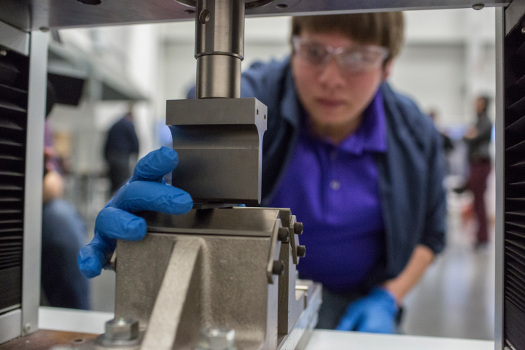 |
| October 23, 2018 | Volume 14 Issue 40 |
Designfax weekly eMagazine
Archives
Partners
Manufacturing Center
Product Spotlight
Modern Applications News
Metalworking Ideas For
Today's Job Shops
Tooling and Production
Strategies for large
metalworking plants
Ford starts using graphene in vehicle parts

In the strength test process, a piece of graphene composite is tested next to a material without graphene -- showcasing the ability of the nanomaterial to hold the load.
It's in cell phones and even some sporting goods -- and soon, for the first time in automotive, it will be under the hood in Ford vehicles. Ford Motor Company recently announced the use of graphene -- a two-dimensional nanomaterial -- in vehicle parts.
Graphene has recently generated enthusiasm and excitement in the automotive industry for paint, polymer, and battery applications.
The ultra-light nanomaterial graphene is 200 times stronger than steel.
Dubbed a "miracle material" by some engineers, graphene is 200 times stronger than steel and one of the most conductive materials in the world. It is a great sound barrier and is extremely thin and flexible. Graphene is not economically viable for all applications, but Ford, in collaboration with Eagle Industries and XG Sciences, has found a way to use small amounts in fuel rail covers, pump covers, and front engine covers to maximize its benefits.
"The breakthrough here is not in the material, but in how we are using it," says Debbie Mielewski, Ford senior technical leader, Sustainability and Emerging Materials. "We are able to use a very small amount, less than a half percent, to help us achieve significant enhancements in durability, sound resistance, and weight reduction -- applications that others have not focused on."
Nearly 1,600 lb/in.2 of force is applied to the graphene composite shown, testing for high strength and stiffness.
Graphene was first isolated in 2004, but application breakthroughs are relatively new. The first experiment to isolate graphene was done by using pencil lead, which contains graphite, and a piece of tape, using the tape to pull off layers of graphite to create a material that is a single layer thick -- graphene. This experiment won a Nobel Prize in 2010.
In 2014, Ford began working with suppliers to study the material and how to use it in running trials with auto parts such as fuel rail covers, pump covers, and front engine covers. Generally, attempting to reduce noise inside vehicle cabins means adding more material and weight, but with graphene, it's the opposite.
"A small amount of graphene goes a long way, and in this case, it has a significant effect on sound absorption qualities," says John Bull, president of Eagle Industries.
Parts made from graphene mixed with foam constituents cannot be distinguished visually from their non-graphene-made counterparts.
The graphene is mixed with foam constituents, and tests done by Ford and suppliers has shown about a 17 percent reduction in noise, a 20 percent improvement in mechanical properties, and a 30 percent improvement in heat-endurance properties compared with foam made without graphene.
Graphene is expected to go into production by year end on over 10 under-hood components on the Ford F-150 and Mustang -- and eventually on other Ford vehicles.
Source: Ford Motor Co.
Published October 2018
Rate this article
View our terms of use and privacy policy
